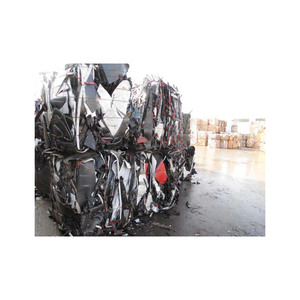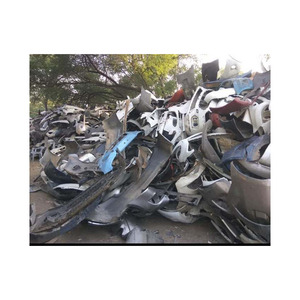(1307 products available)
























































































































































A scrap plastic car bumper is a common sight on roads today. A plastic car bumper is made from thermoplastic or thermosetting plastic. They are used in most modern vehicles because they are light and cheap. Plastic car bumpers are used to improve fuel efficiency and lower production costs. However, they are not easy to recycle. Different types of plastics are used in vehicles for different purposes. This means that a vehicle may have parts made from more than one type of plastic. Here are some common types of plastics used in car bumpers.
Other plastics that may be found in car bumpers include polyethylene (PE), which is used in some foams and fillers; and ABS/PC alloys, which combine the strengths of ABS and polycarbonate for critical structural components.
Car bumpers are manufactured in different sizes and designs to suit various vehicles. Manufacturers provide detailed information regarding the size, weight, and material used to make a car bumper. Here are some specifications to look out for when shopping for bumpers:
Size
Car bumpers come in different sizes depending on the type of vehicle. For instance, the bumpers for small vehicles are smaller compared to those of bigger cars like trucks and buses.
Design
Scrap car bumpers are designed to suit different vehicles. Manufacturers provide a design that resembles the original bumper of the car. It is easier to replace a car bumper with one that looks like the original one.
Weight
Plastic car bumpers for front collision are manufactured using heavy materials like steel. Such bumpers are heavy compared to those made using lighter materials like plastic.
Maintaining a car bumper is important to ensure it lasts long and functions well. Here are some maintenance tips:
There are several factors to consider before buying plastic scrap car bumpers. They include:
Condition
The condition of the car bumper is an important factor to consider. It determines the suitability of the bumper for various uses. For instance, a scrap car plastic bumper in good condition can be used for resale purposes or even recycling to manufacture new plastic products. Bumpers with minor damages like dents are more preferable than those with major issues like cracks or deep scratches. This is because the former can be easily repaired or fixed. Plastic car bumpers that are in great condition will offer more value to businesses.
Type
There are different types of car bumpers. They include front and rear bumpers. Front bumpers are more in demand because they are often used to replace the rear ones. Other than the type of the bumper, the style and design also matter. Select bumpers that have popular designs and styles that are going to be in demand.
Vehicle compatibility
Consider the make, model, and year of the vehicle that the bumper was originally designed for. Some bumpers are designed for specific vehicles only. This makes it hard to find a suitable car for some bumpers. It is advisable to choose plastic scrap car bumpers that are going to fit in various vehicles. This improves their compatibility and makes it easier to find a suitable car for them.
Source
It is important to consider where the plastic car bumpers are coming from. This is because they can be obtained from a junkyard, private seller, or auto-repair shop. Bumpers that have been sourced from a reputable provider are more likely to be in good condition. This is because most providers inspect and assess the condition of the bumpers before selling them.
Price
Different suppliers are going to offer plastic car bumpers at various prices. It is important to do proper research and have a budget in mind. This helps in finding a supplier that offers car bumpers within the budget. But remember, the price of the bumper should also match its value.
The process of replacing a scrap plastic car bumper is straightforward. First, buyers should ensure that the necessary tools and parts are available.
Here is a step-by-step guide on how to replace scrap plastic car bumpers.
Safety Precautions:
Turn off the ignition and put on safety glasses and gloves. This will protect the eyes from possible injuries and the hands from sharp objects.
Remove the Old Bumper:
Using a socket set, the screws and bolts holding the bumper are removed. The screws are located on the top and bottom of the bumper. The screws located at the bottom are usually hidden, so the driver may need to raise the car with a jack. Also, the plastic clips and trim fasteners are removed using a flathead screwdriver.
Disconnect Electrical Components:
If the bumper has any electrical components, such as sensors or lighting, the electrical connections are disconnected.
Inspect and Repair:
The mounting points and other surrounding areas where the new bumper will be installed are inspected for damage and repaired if necessary.
Prepare the New Bumper:
The new bumper is prepared for installation by attaching any necessary mounting hardware and installing any electrical components.
Install the New Bumper:
The new bumper is aligned with the mounting points and pressed gently until it is secured. The bolts and screws are tightened using a socket set. The socket set is also used to tighten the bolts gently to avoid breaking them.
Reconnect Electrical Components:
The electrical connections are reconnected. This is done by following the disconnection procedure in reverse.
Test and Inspect:
The bumper is tested to ensure it is properly aligned and secured. The electrical components are also tested to ensure they are functioning correctly.
Final Check:
With the new bumper installed, the vehicle is lowered from the jack. The technician does a final check to ensure everything is properly installed and functioning.
Q1: What are scrap plastic car bumpers made of?
A1: Car bumpers are usually made from thermoplastic and thermosetting plastic. The latter is often used in older car models. It is hard and cannot be melted or reshaped.
Q2: How can people recycle bumpers?
A2: Recycling companies can recycle scrap plastic car bumpers by using advanced technologies. They can grind the plastics into small pieces and wash them to get rid of contaminants. Then, they can heat the pieces and bond them together to form a new shape.
Q3: What are the benefits of recycling plastic car bumpers?
A3: Recycling plastic car bumpers is good for the environment because it reduces carbon emissions. It also saves natural resources by reducing the need for mining and drilling. As a result, it creates a cleaner and healthier environment.